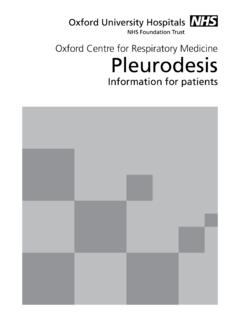Transcription of Department of Dermatology Efudix 5% cream - ouh.nhs.uk
1 Department of DermatologyEfudix 5% creamInformation for patientspage 2 You have been prescribed a cream called Efudix . This leaflet has been written to give you further information about what the cream is used for, how to use it, and what side effects you should is Efudix cream ? Efudix cream contains the chemical 5-fluoruracil. This chemical is proven to be active against early forms of skin cancer and pre-malignant skin conditions, such as actinic (solar) keratoses, Bowen s disease and superficial basal cell carcinoma. When should I apply the cream ?Apply either in the morning and evening or once in the evening, after washing the area of skin that is to be treated.
2 You will be told in clinic how often to apply the cream and where. There is also space at the back of this leaflet for your individual treatment plan to be should I apply the cream ?The cream can be applied to either the individual skin lesion or to the surrounding area as well. If you are applying the cream to the surrounding area, skin that is not yet visibly damaged will also be treated this is called field treatment . Different regions of the face can be treated at the same time, forehead and temples. However, if the sun damage is widespread you may find it easier to treat different sections in stages, one after the other.
3 Your doctor can advise you on this. The larger the area treated the more dramatic the redness and inflammation will be (see What are the side effects of Efudix cream ? on page 5).page 3page 4 How much cream should I use?Apply the cream with a clean fingertip. If you are treating your whole face, use four pea-sized amounts of cream ; one on the chin, each cheek and the forehead. For selected areas, just use one pea-sized amount of cream . Wash your hands after applying the Efudix I use moisturiser as well?Moisturiser may be applied 20 minutes after applying the Efudix cream . Please wash or clean affected areas as normal, but avoid products which may sting or irritate your skin.
4 If your skin becomes too irritated with treatment (see page 5) please use a soap-free product to wash. Your pharmacist can give you advice on what to can apply a small amount of makeup 20 minutes after applying Efudix , as long as the skin is not broken or I continue with sunscreen?Sunscreen is a very important part of treatment for sun damaged skin, to help prevent further damage. Efudix cream can make you more sensitive to sunlight, particularly during the warmer months. The reaction may also be more severe if you have excess sun exposure during your broad spectrum sunscreen (SPF30 or above) should be applied every day before going outdoors, and reapplied regularly through the day.
5 Don t forget to wear a hat, long sleeves and trousers (or a long skirt), to protect your 5 What are the side effects of Efudix cream ?The main side effect is skin irritation (dermatitis). The cream works by directly destroying the sun-damaged skin cells. This will cause intense inflammation, crusting, redness and oozing of the whole area treated. Inflammation is a good sign, as it shows the cream is having an effect. If the inflammation is too uncomfortable a steroid cream can be prescribed to calm down the inflammation. Sometimes treatment is reduced (for example, to use on alternate days) if the reaction is severe, but a full course of treatment is required your Dermatology doctor can advise you on this.
6 Generally, the more intense the inflammation the better the end result! For more information and to see some pictures of the expected reaction, visit: long should I continue with the treatment?After 2-4 weeks your skin will be red, crusty, and uncomfortable; this is what we want to happen. In some cases, such as for lesions on the backs of the hands, the body, or for basal cell carcinoma, it might take longer to get to this stage (4-6 weeks). The cream can then be stopped, to allow healing. Treatment can vary from person to person. Your Dermatology doctor will tell you how long you need to use it for. The treatment can be repeated after a couple of months for any remaining areas of sun damage.
7 Your GP can also prescribe this cream for you if further solar keratoses 6 When should I start to see an effect?The time for results to show varies from person to person. The following is a guide as to when to expect results: 1-3 weeks Inflammation with crusting and redness of the skin 3-6 weeks Skin inflammation settling down 6-16 weeks Clearance of the sun damaged skinFollow-upIt is usually not necessary for follow-up appointments to be arranged. However, if you have any concerns about the treatment please contact the Department on the number below, or visit your GP. How to contact usIf you need more advice or support, please telephone us: Dermatology Outpatients, Churchill Hospital Tel: 01865 228 241 Out of hours: Please contact your GP or call NHS 111page 7 Your Efudix treatment planEfudix cream to be applied.
8 Times daily for .. weeks, to the following areas:OMI 13885 PIf you have a specific requirement, need an interpreter, a document in Easy Read, another language, large print, Braille or audio version, please call 01865 221 473 or email Dr Stephanie ArnoldSeptember 2016 Review: September 2019 Oxford University Hospitals NHS Foundation TrustOxford OX3
















